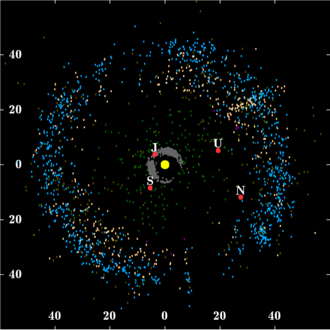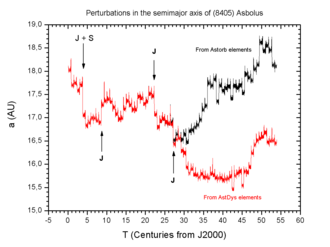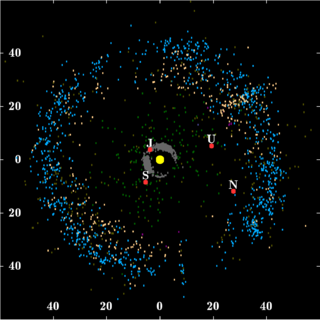
The Kuiper belt is a circumstellar disc in the outer Solar System, extending from the orbit of Neptune at 30 astronomical units (AU) to approximately 50 AU from the Sun. It is similar to the asteroid belt, but is far larger—20 times as wide and 20–200 times as massive. Like the asteroid belt, it consists mainly of small bodies or remnants from when the Solar System formed. While many asteroids are composed primarily of rock and metal, most Kuiper belt objects are composed largely of frozen volatiles, such as methane, ammonia, and water. The Kuiper belt is home to most of the objects that astronomers generally accept as dwarf planets: Orcus, Pluto, Haumea, Quaoar, and Makemake. Some of the Solar System's moons, such as Neptune's Triton and Saturn's Phoebe, may have originated in the region.

The Solar System is the gravitationally bound system of the Sun and the objects that orbit it. The largest of these objects are the eight planets, which in order from the Sun are four terrestrial planets ; two gas giants ; and two ice giants. The Solar System developed 4.6 billion years ago when a dense region of a molecular cloud collapsed, forming the Sun and a protoplanetary disc.
A trans-Neptunian object (TNO), also written transneptunian object, is any minor planet in the Solar System that orbits the Sun at a greater average distance than Neptune, which has an orbital semi-major axis of 30.1 astronomical units (au).

2060 Chiron is a small Solar System body in the outer Solar System, orbiting the Sun between Saturn and Uranus. Discovered in 1977 by Charles Kowal, it was the first-identified member of a new class of objects now known as centaurs—bodies orbiting between the asteroid belt and the Kuiper belt.
5145 Pholus is an eccentric centaur in the outer Solar System, approximately 180 kilometers in diameter, that crosses the orbit of both Saturn and Neptune. It was discovered on 9 January 1992 by American astronomer David Rabinowitz (uncredited) of UA's Spacewatch survey at the Kitt Peak National Observatory in Arizona, United States. The very reddish object has an elongated shape and a rotation period of 9.98 hours. It was named after the centaur Pholus from Greek mythology.
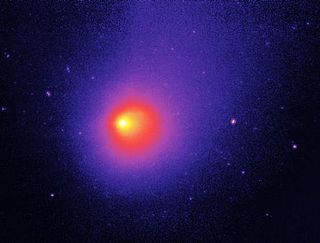
Comet 29P/Schwassmann–Wachmann, also known as Schwassmann–Wachmann 1, was discovered on November 15, 1927, by Arnold Schwassmann and Arno Arthur Wachmann at the Hamburg Observatory in Bergedorf, Germany. It was discovered photographically, when the comet was in outburst and the magnitude was about 13. Precovery images of the comet from March 4, 1902, were found in 1931 and showed the comet at 12th magnitude. It reached the last perihelion on March 7, 2019. It came to opposition in late December 2022.
8405 Asbolus is a centaur orbiting in the outer Solar System between the orbits of Jupiter and Neptune. It was discovered on 5 April 1995, by James Scotti and Robert Jedicke of Spacewatch (credited) at Kitt Peak Observatory in Arizona, United States. It is named after Asbolus, a centaur in Greek mythology and measures approximately 80 kilometers in diameter.

(55565) 2002 AW197 (provisional designation 2002 AW197) is a classical, non-resonant trans-Neptunian object from the Kuiper belt in the outermost region of the Solar System, also known as a cubewano. With a likely diameter of at least 700 kilometers (430 miles), it is approximately tied with 2002 MS4 and 2013 FY27 (to within measurement uncertainties) as the largest unnamed object in the Solar System. It was discovered at Palomar Observatory in 2002.

The scattered disc (or scattered disk) is a distant circumstellar disc in the Solar System that is sparsely populated by icy small Solar System bodies, which are a subset of the broader family of trans-Neptunian objects. The scattered-disc objects (SDOs) have orbital eccentricities ranging as high as 0.8, inclinations as high as 40°, and perihelia greater than 30 astronomical units (4.5×109 km; 2.8×109 mi). These extreme orbits are thought to be the result of gravitational "scattering" by the gas giants, and the objects continue to be subject to perturbation by the planet Neptune.
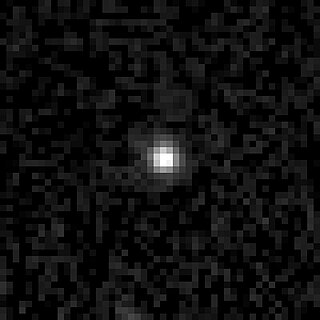
10199 Chariklo is the largest confirmed centaur. It orbits the Sun between Saturn and Uranus, grazing the orbit of Uranus. On 26 March 2014, astronomers announced the discovery of two rings around Chariklo by observing a stellar occultation, making it the first minor planet known to have rings.
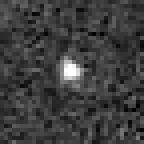
10370 Hylonome (; prov. designation: 1995 DW2) is a minor planet orbiting in the outer Solar System. The dark and icy body belongs to the class of centaurs and measures approximately 72 kilometers (45 miles) in diameter. It was discovered on 27 February 1995, by English astronomer David C. Jewitt and Vietnamese American astronomer Jane Luu at the U.S. Mauna Kea Observatory in Hawaii, and later named after the mythological creature Hylonome.
60558 Echeclus is a centaur, approximately 84 kilometers (52 miles) in diameter, located in the outer Solar System. It was discovered by Spacewatch in 2000 and initially classified as a minor planet with provisional designation 2000 EC98 (also written 2000 EC98). Research in 2001 by Rousselot and Petit at the Besançon observatory in France indicated that it was not a comet, but in December 2005 a cometary coma was detected. In early 2006 the Committee on Small Bodies Nomenclature (CSBN) gave it the cometary designation 174P/Echeclus. It last came to perihelion in April 2015, and was expected to reach about apparent magnitude 16.7 near opposition in September 2015.
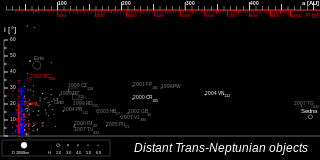
Detached objects are a dynamical class of minor planets in the outer reaches of the Solar System and belong to the broader family of trans-Neptunian objects (TNOs). These objects have orbits whose points of closest approach to the Sun (perihelion) are sufficiently distant from the gravitational influence of Neptune that they are only moderately affected by Neptune and the other known planets: This makes them appear to be "detached" from the rest of the Solar System, except for their attraction to the Sun.
The five-planet Nice model is a numerical model of the early Solar System that is a revised variation of the Nice model. It begins with five giant planets, the four that exist today plus an additional ice giant between Saturn and Uranus in a chain of mean-motion resonances.
The jumping-Jupiter scenario specifies an evolution of giant-planet migration described by the Nice model, in which an ice giant is scattered inward by Saturn and outward by Jupiter, causing their semi-major axes to jump, and thereby quickly separating their orbits. The jumping-Jupiter scenario was proposed by Ramon Brasser, Alessandro Morbidelli, Rodney Gomes, Kleomenis Tsiganis, and Harold Levison after their studies revealed that the smooth divergent migration of Jupiter and Saturn resulted in an inner Solar System significantly different from the current Solar System. During this migration secular resonances swept through the inner Solar System exciting the orbits of the terrestrial planets and the asteroids, leaving the planets' orbits too eccentric, and the asteroid belt with too many high-inclination objects. The jumps in the semi-major axes of Jupiter and Saturn described in the jumping-Jupiter scenario can allow these resonances to quickly cross the inner Solar System without altering orbits excessively, although the terrestrial planets remain sensitive to its passage.
2015 FJ345 is a trans-Neptunian object and detached object, located in the scattered disc, the outermost region of the Solar System. It was first observed on 17 March 2015, by a team led by American astronomer Scott Sheppard at the Mauna Kea Observatories, in Hawaii, United States. With its perihelion of almost 51 AU, it belongs to a small and poorly understood group of very distant objects with moderate eccentricities. The object is not a dwarf planet candidate as it only measures approximately 120 kilometers (75 miles) in diameter.
Centaurus is a mission concept to flyby the centaurs 2060 Chiron and Schwassmann–Wachmann 1. It was submitted in response to the NASA Discovery program call for proposals in 2019 but ultimately was not among the four missions selected for further development by NASA in February 2020. If it had been selected, Centaurus would have been the first mission to attempt a flyby of a centaur.
Chimera is a NASA mission concept to orbit and explore 29P/Schwassmann-Wachmann 1 (SW1), an active, outbursting small icy body in the outer Solar System. The concept was developed in response to the 2019 NASA call for potential missions in the Discovery-class, and it would have been the first spacecraft encounter with a Centaur and the first orbital exploration of a small body in the outer Solar System. The Chimera proposal was ranked in the first tier of submissions, but was not selected for further development for the programmatic reason of maintaining scientific balance.
P/2020 MK4 (PanSTARRS) is a Chiron-type comet or active centaur orbiting in the outer Solar System between Jupiter and Saturn. It was discovered on 24 June 2020, by the Pan-STARRS survey at Haleakala Observatory in Hawaii, United States.
